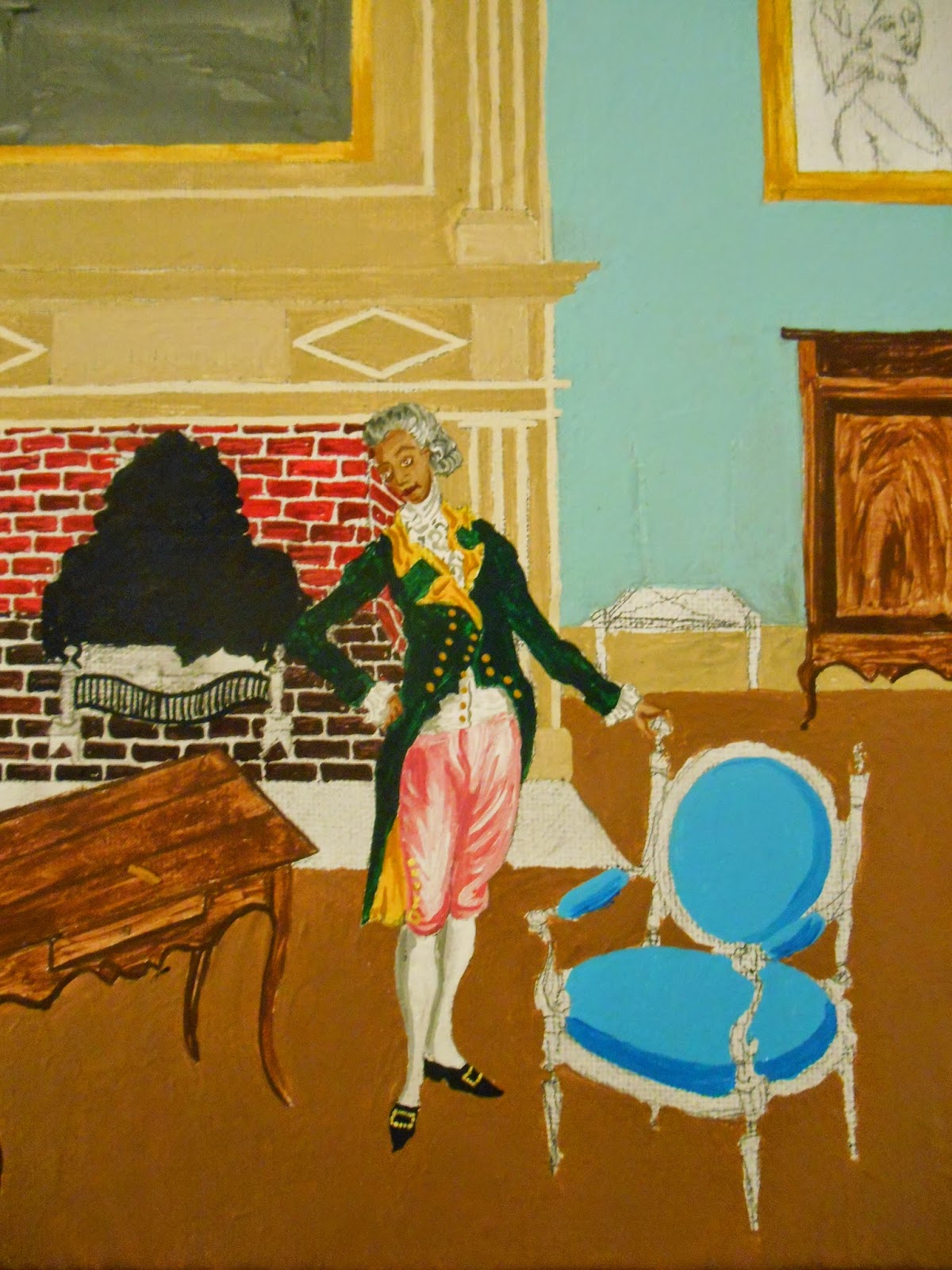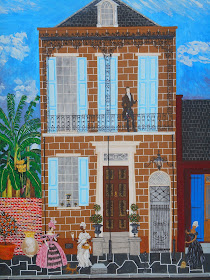Wandering Musicians 1828 by Francois-Joseph Navez
Friday, June 27, 2014
Monday, June 23, 2014
La Maison du Free Man of Color
"La Maison du Free Man of Color" by Andrew LaMar Hopkins
One of my favorite paintings titled "La Maison du Free Man of Color" sold about a week ago at Nadine Blake's along with 6 others over a 48 hour period. "La Maison du Free Man of Color" is the first of my paintings I documented from beginning to end. Lot's of people want to know how I paint a painting from start to finish. I decided to start a facebook page to document my art and the steps in making it. Being self taught and not academically trained I have my own way of painting that is very different from formally trained artist. Instead of painting on a easel I paint with the canvas on my lap. Because of this I don't paint on stretched canvas, I love canvas board.
"La Maison du Free Man of Color" shows a well appointed late 18th century
Creole salon of a Creole gentleman of color. He is fashionably dressed in
the latest fashion from France including a powdered wig. His parents
portraits are over the Louisiana made French styled chest. A mother of African descent and a French
aristocrat father.
A portrait of the Creole gentleman of color as a child in a gilt
wood Louis XV frame hangs over the mantel. The Creole mantle and over mantel
are copied from Columbia Plantation 1782. 18th century Louisiana inventories
of interiors list locally made pieces of furniture Like the Creole
armoire, a Louisiana walnut pied-de-biche center table and the chest with
Cabriole Legs were mixed with fine imported furniture from France like the Louis
XVI gilded sofa and arm chair.
Other imported items in the room are
decorative arts like the blue and white delft vases on the mantel. The French cast
iron fireback in the fireplace. The Louis XV mantel clock, The Louis XVI
gilt wood mirror over the mantel. The French faïence pottery on the chest
and silver candlesticks would have been fancy items available in a port city
like New Orleans.
The term free people of color (French: gens de couleur
libres), at first specifically referred to persons of partial African and
European descent who were not enslaved. The term was especially used in the
French colonies, including La Louisiane and settlements on Caribbean
islands, such as Saint-Domingue, Guadeloupe, and Martinique.
Free people of
color developed as a separate class between the colonial French and Spanish and
the enslaved black African workers. They often achieved education and some
measure of wealth; they spoke French and practiced Catholicism,
The first step. The drawing of La Maison du Free Man of Color before paint is applied.
Most of the decorative arts and furniture are picked out of my vast collection of photo's of antiques. While other items are latter added while the painting is still being painted.
Step 2, I try to cover the drawing all in paint. Note the Louisiana ladder back chairs are painted out from the drawing.
3, Some finer details are painted right away like the fabrics in the clothing while others just have base paint like the fabric on the chair to be latter touched up.
Now the portraits come alive in the painting. One of the number 1 things people love about my paintings are the portraits and paintings in my paintings.
4, Now stuff pops into the paintings that was not in the original drawing. Like the blue and white delft vases on the mantel. The Louis XV mantel clock, The French faïence pottery on the chest.
5, The French Louis XVI arm chair now has it's gilding
6, Finishing touches are added to the painting and then it is varnished!
"La Maison du Free Man of Color" by Andrew LaMar Hopkins complete.
My painting centers around the Creole 18th century mantle and over mantel
copied from Columbia Plantation circa 1782. A early Louisiana Colonial house now being restored. The photo by Jacques Levet Jr.
Detail of the wonderful gouge work on Columbia Plantation mantel. photo by Jacques Levet Jr.
Detail of the wonderful gouge work on Columbia Plantation mantel. photo by Jacques Levet Jr.
Columbia Plantation circa 1782. photo by Jacques Levet Jr.
18th century French portrait of a boy that I turned into a Free boy of color in my painting
18th century French Louis XVI mirror used in my painting
A French Louis XVI gilded arm chair.
A 18th century Louisiana walnut pied-de-biche center table with
Cabriole Legs
cast iron & brass fireback and grate
Louisiana Armoire with Inlay. Mahogany, Tulip Poplar, Yellow Pine, Satinwood, Holly & Maple. Pied de Biche Feet on Cabriole Legs.
French Louis XVI Giltwood Canape
Jean-Etienne Liotard (1702-1789) - Portrait of a Young Woman. Oil on Canvas. France. Circa Mid-18th Century.
French 18th century portrait of a French
aristocrat.
A Louisiana walnut pied-de-biche chest with
Cabriole Legs
"La Maison du Free Man of Color" by Andrew LaMar Hopkins
You can follow my art on facebook at
https://www.facebook.com/andrewhopkinsfolkart
Saturday, June 21, 2014
Louis de Boullogne de Younger (French, 1654 - 1733), Apollo Teaching Hyacinth to Play Lyra, circa 1688
Louis de Boullogne de Younger (French, 1654 - 1733), Apollo Teaching Hyacinth to Play Lyra, circa 1688, Chateau de Versailles
Friday, June 20, 2014
Wednesday, June 18, 2014
Paris porcelain teapot illustrated with a ballooning scene, late 18th century
A white and gold porcelain teapot from the Penn-Gaskell collection of 'ballooniana'. Public balloon ascents began to be held in pleasure gardens after the first successful balloon trips in Paris in 1783. These events attracted huge crowds and led to an explosion of 'ballooniana', or balloon art, expressed in paintings, prints and decorated ceramics as well as many other forms.
Sunday, June 15, 2014
Vieux Carré
Vieux Carré by Andrew LaMar Hopkins
Yesterday my painting titled Vieux Carré sold in Nadine Blakes shop located at 1036 Royal street here in in New Orleans. Nadine has sold over 16 of my paintings over the last 6 weeks. This has been exciting and a little scary as I can't paint 16 paintings in a 6 week period. I try to have on hand 30 of my paintings available at any time and now I'm down to under half that amount. "Vieux Carré" showing a French Quarter Streetscape of about 1830.
Depicts a street scene of the Old French Quarter in French "Vieux Carré". I got the ideal to paint this painting walking down Royal street. The colors came first. I thought wouldn't a praline colored stucco building with light blue shutters look great on a French Quarter building. Next I picked out a building in the French Quarter I liked a two story Greek Revival Creole town house that I could use the colors on located on Burgundy street.
This is the balcony of the house in the French Quarter that I got the ideal to do Vieux Carré.
Vieux Carré
3rd transform this scene back to the early 19th century. A free woman of color with a tignon headdress sweeps the flagstone sidewalk in front of her early 19th century Creole cottage. A tignon Creole of color street vendor sells Creole Delicacies to a French Creole lady on the flagstone sidewalk, a common sight in 19th and 20th century Creole New Orleans.
A tignon Creole of color street vendor sells Creole Delicacies to a French Creole lady on the flagstone sidewalk, a common sight in 19th and 20th century Creole New Orleans.
This Antebellum street scene was common in 19th century New Orleans but New Orleans was the only place in America where black and white property owners live side by side. gens de couleur owned about one-third of the land in the French Quarter . Free woman of color obtained land in the Quarter and surrounding areas most by Plaçage.
Plaçage was a recognized extralegal system in French and Spanish slave colonies of North America (including the Caribbean) by which ethnic European men entered into the equivalent of common-law marriages with women of color, of African, Native American and mixed-race descent. The term comes from the French placer meaning "to place with". The women were not legally recognized as wives but were known as placées; their relationships were recognized among the free people of color as mariages de la main gauche or left-handed marriages.
They became institutionalized with contracts or negotiations that settled property on the woman and her children, and in some cases gave them freedom if enslaved. The system flourished throughout the French and Spanish colonial periods, reaching its zenith during the latter, between 1769 and 1803. It was most practiced in New Orleans, where planter society had created enough wealth to support the system. It also took place in the Latin-influenced cities of Natchez and Biloxi, Mississippi; Mobile, Alabama; St. Augustine and Pensacola, Florida] as well as Saint-Domingue (present-day Haiti). Plaçage became associated with New Orleans as part of its cosmopolitan society.
A free woman of color with a tignon headdress sweeps the flagstone sidewalk in front of her early 19th century Creole cottage a common sight in 19th and 20th century Creole New Orleans.
A typical French Quarter early 19th century Creole cottage. This type of house was obtained by Free woman of color with Plaçage.
A Creole gentleman surveys the French Quarter from his Classical cast iron Veranda.
This painting also incorporates Neoclassical wrought iron alley gates. Wrought iron gas light. Cast iron urns planted with kumquats. A wood grained mahogany front door. A set of Old Paris porcelain vases can be seen in the window. A french olive jar on the flagstone sidewalk next to a potted kumquat. Banana trees can be seen over the brick wall. On the flagstone sidewalk in front of the house is a granite carriage step is signed and dated by the artist.
My exhibit is still up at Nadine Blake, If you are in New Orleans stop by. 1036 Royal St
New Orleans, Louisiana 70116


















































